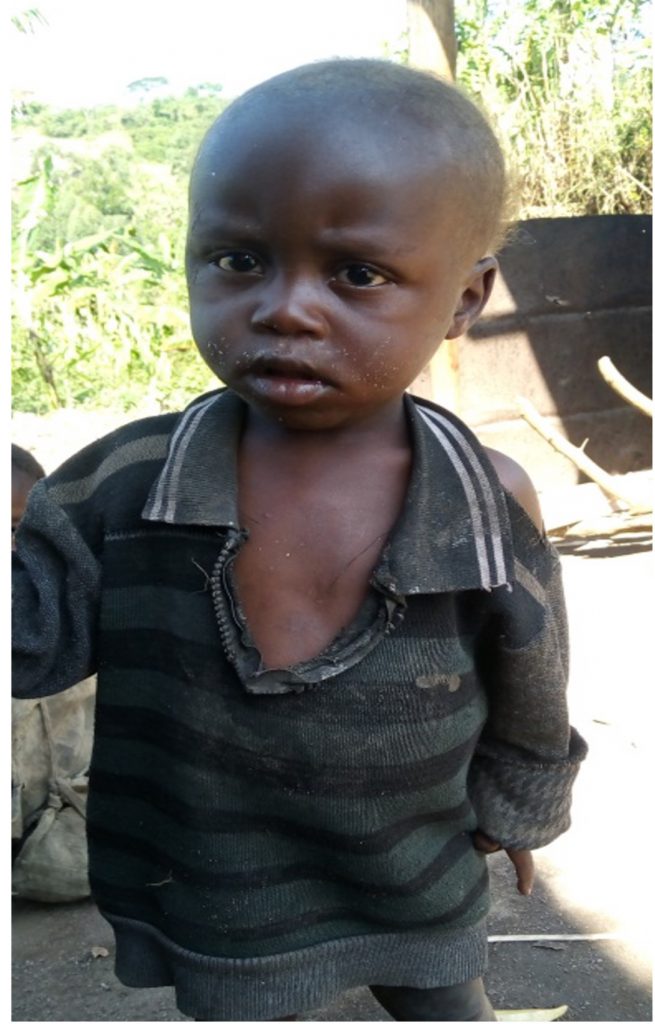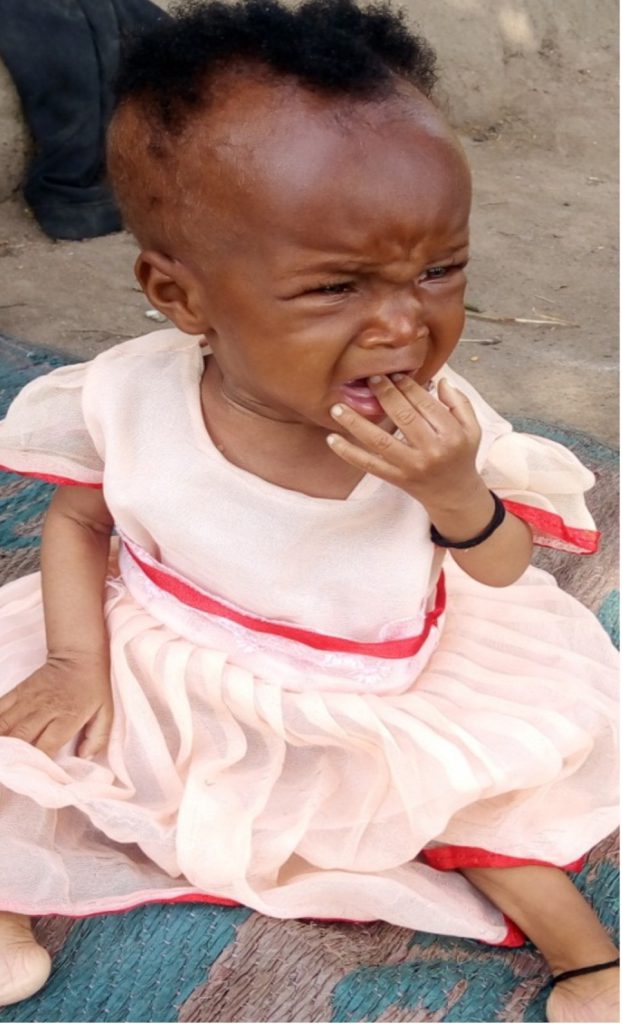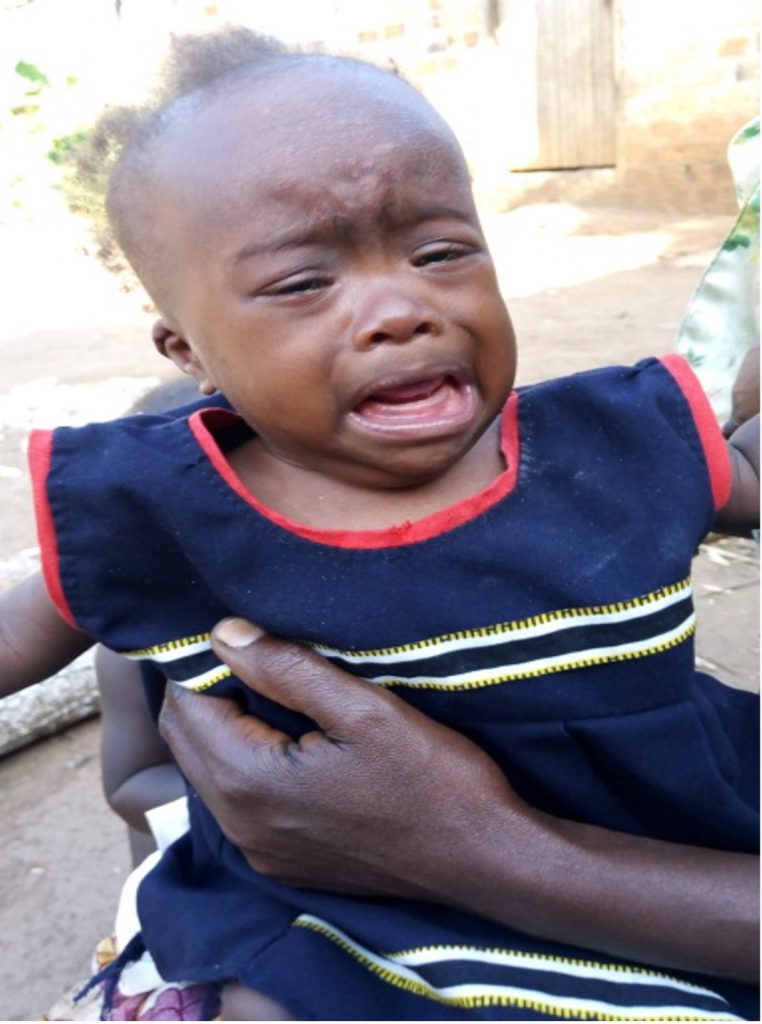Kitokoloprojekt in Uganda im März 2025
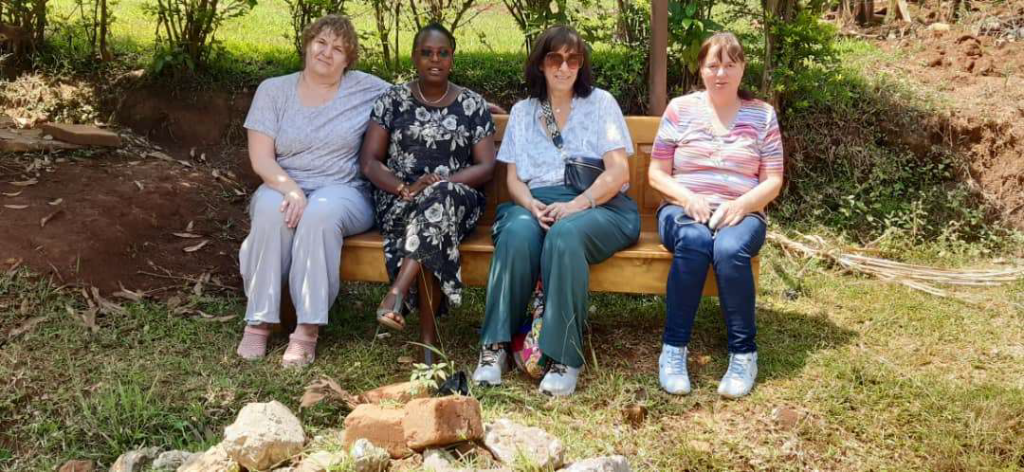
Den März konnte ich mit meinen zwei Mitstreiterinnen Karin und Barbara im Kitokoloprojekt in
Uganda verbringen. Wir konnten uns von den umgesetzten Projekten im vergangenen Jahr
überzeugen und daran freuen. So wurden Internate und Lehrerwohnungen für die neue Grundschule
fertiggestellt und mancherlei Programme zur Hilfe der Notleidenden Menschen umgesetzt.
Wir trafen auch unsere ca. 200 Patenkinder und machten Fotos für die Paten zu Hause. Die
Spendengelder wurden in den Buchhaltungsunterlagen kontrolliert und neue Pläne für das
kommende Jahr geschmiedet.
Obwohl sich in den letzten Jahren viel zum Positiven verändert hat, herrscht in den Dörfern oft noch
große Armut. Über eine Tonne Lebensmittel konnten wir verteilen und auch über mitgebrachte
Anziehsachen wurde sich gefreut.
Als wir ankamen, war alles sehr vertrocknet und das Saatgut konnte nicht eingebracht werden. Die
Menschen waren sehr um ihre Nahrung für die nächsten Monate besorgt. Dann schenkte unser
gnädiger HERR den Regen. Halleluja!!! Wir sind sehr dankbar für alle Gebete und die gesegnete Zeit!
Abschlussfeier der Berufsschule:
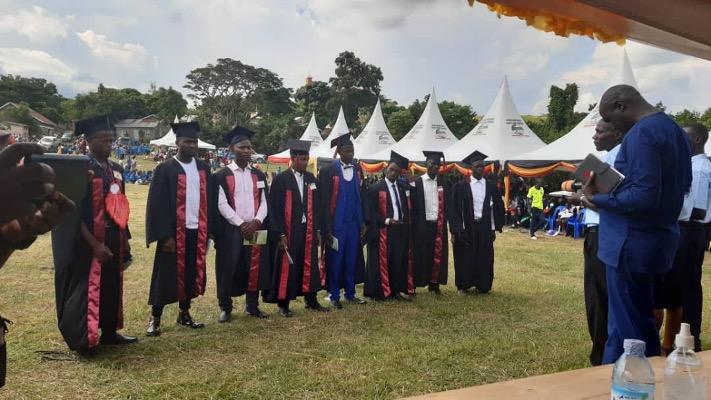
Schulausflug der Klassen 4-7 nach Entebbe in den Zoo, Flughafen und Freedom City :
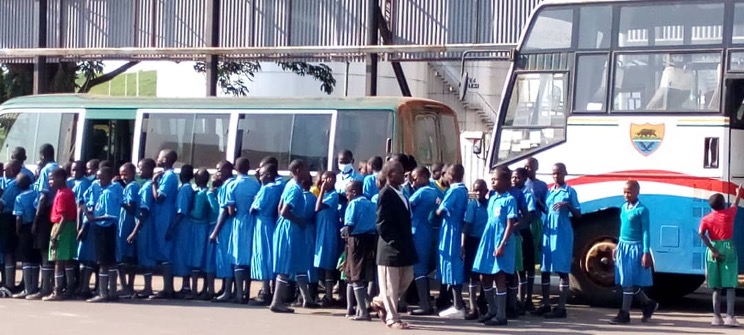
Vielen Dank für jegliche Unterstützung!
KITOKOLO HEALTH CENTRE BABY BLANKETS SUPPORT REPORT
Introduction:
This wonderful project started in January 2021 with an aim to give a very Baby born at Kitokolo Health Centre II a Baby Shoal (Blanket). The idea followed the Birth of Lydias’ Baby Born in Germany on the 1stof January 2021.
The support was timely to the community with given the high poverty levels in the community served by Kitokolo Health Centre II. Some women deliver at home because they lack baby closes, can’t afford the user fee charged ranging from 30,000/= to 50,000/= depending on the state of delivery.
Kitokolo Health Center under her maternity services works to minimize home delivering that lead to maternal and neonatal deaths that could be avoided if a mothers delivered from a medical Centre.
Since 1stJanuary to 25thMay 2021, 41 mothers have each received a baby shoal.
Achievements /impact of baby Shoal Support.
- Increase in numbers of mothers delivering at the facility both from Kitokolo catchment area and beyond. 41 mothers have delivered at Kitokolo Health Centre between January and May 2021 compared to 22 mothers who came in the same period in 2020. We received more mothers since March 2021.
- Mothers feel honored and being catered for as baby blankets seemed to be a burden to them due to low income status. Mothers coming to the facility without baby clothes and personal effects has always been a challenge.
- Advocacy of Kitokolo Health Centre services in areas beyond the catchment area thus increasing on client turn-over.
Mothers with their babies on receiving baby blankets:
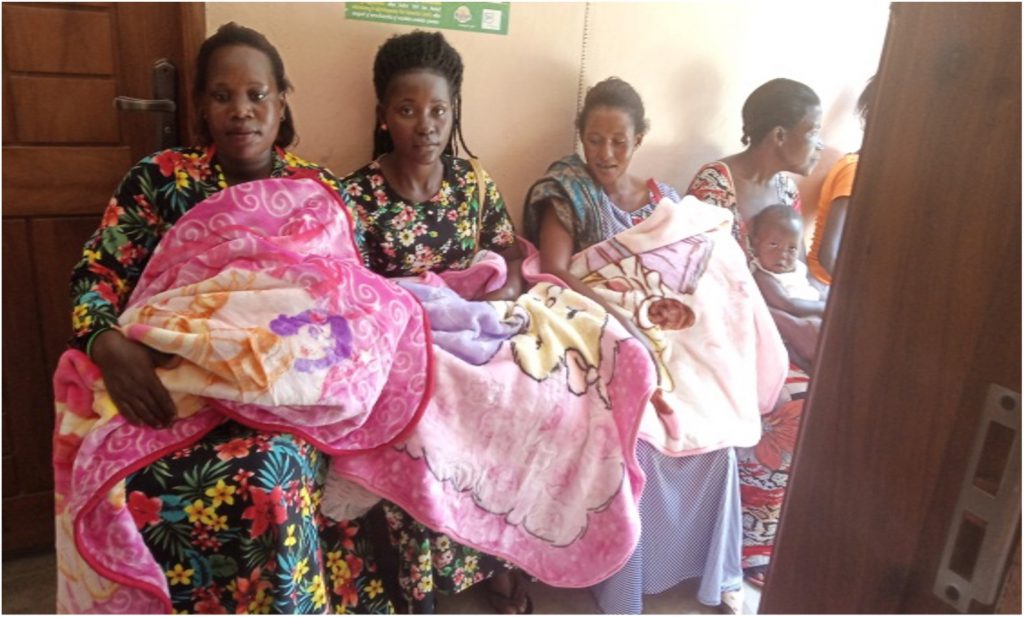

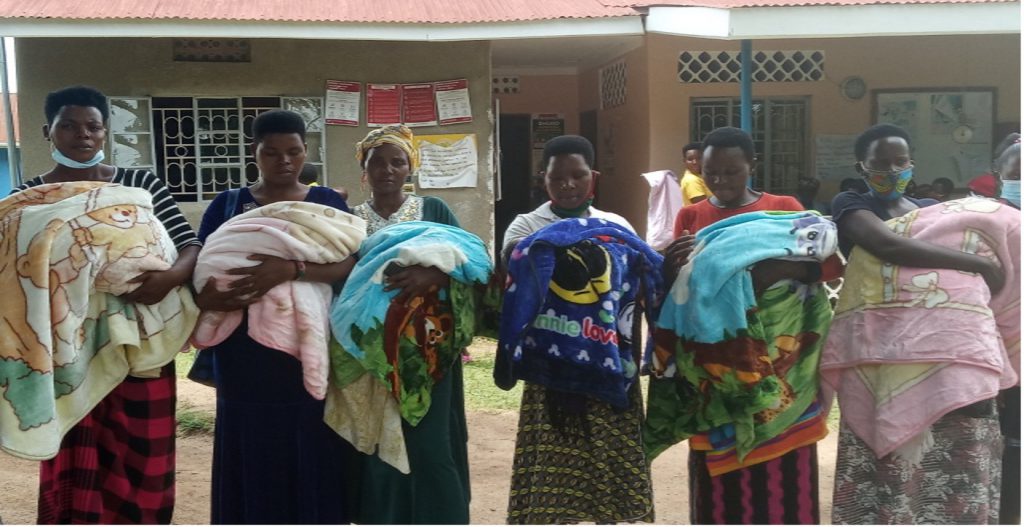



Acknowledgement.
I take this opportunity to thank Hope For The Needy Uganda and her partners for the support given to Kitokolo Health Centre that continues to improve our services. Along with, we appreciate the baby clothes received in the past years, community health support and health camps benefiting the community vulnerable persons.
I thank HONU management, the facility staff for the proposals and support in serving the under privileged population of Kitokolo and her surrounding villages.
God bless you all.
Compiled by.
Nakasiita Eron (ass.in-charge)
A DONATION MAKING A DIFFERENCE TO A PROSMISSING END.
5 children were enrolled into the malnutrition program at Kitokolo Health Centre II following funds raised from friends in Czech Republic and in Germany. Adding to the number from 24 to 29 children in the whole program.
The report focuses on five children that have been receiving food supplements twice a month since July 2020. The foods given are powdered milk, silver fish, baby soya, rice porridge, cassava floor mixed with maize floor and medication whenever they fall sick all possible due to your support.
The children pictures and history taken at enrollment:
Group photo of the same children at enrolment with their guardians.
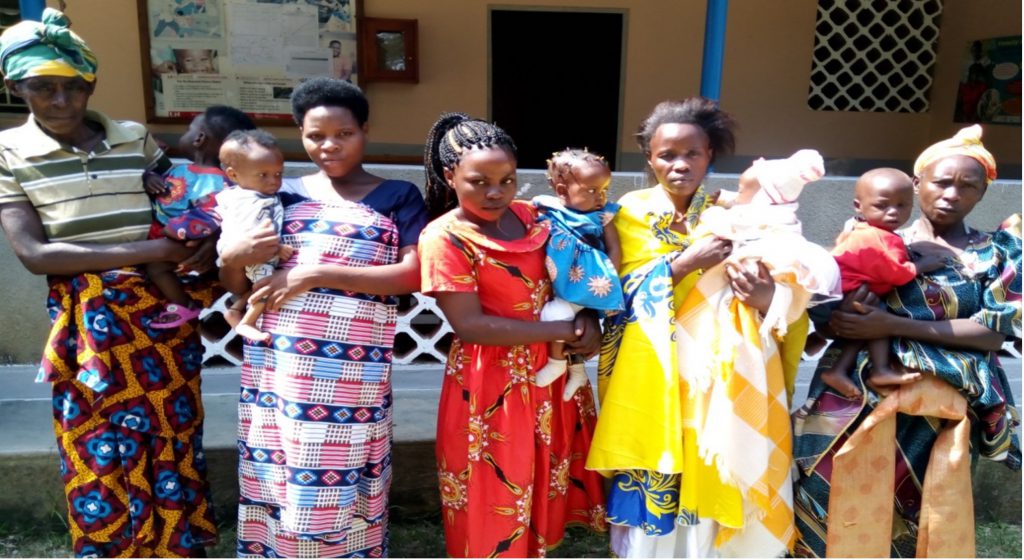
Below are the pictures of some of the children with an improvement after receiving food supplements four times in 2020. Two of them were discharged.
Left to right (Christopher, Rose, Bosco, and Favour)- 2 months after enrollement.




This is what you support means, some children loss lives due to poor feeding and lack of medication and yet would have lived to a full life and potential. Look at their arms, legs & cheeks in the photos before and during the treatment. Christopher and Bosco were discharged in Good health in February 2021, Favours’ mother separated and went with the child. The two roses remain to be discharged.
By Ivan-health worker & Annette
Fundraising for the Church construction
Spendensammlung für Kirchenbau
In support of Spiritual Ministry by Hope For The Needy Uganda, a Church with a gallery is under construction at Kitokolo Village. Um den geistlichen Dienst zu unterstützen, entsteht durch „Hope For The Needy Uganda“ eine neue Kirche mit einer Galerie.
Beneficiaries: Community Christians, pupils, students and HONU Staff adding up to 600 and above congregants. On behalf of the Christians, we are grateful for the works to Beam level I and a galley slab constructed. Nutznießer: Christliche Gemeinde, Schüler, Studenten und Mitarbeiter HONU, zusammen über 600 Gläubige. Im Namen der Christen sind wir dankbar für die Fertigstellung des Erdgeschosses und sowie der Zwischendecke zur Galerie.

This great work has been possible with support from partners and friends of Kitokolo, the Kitokolo community Christians, Church goers and Non-Church goers’ contributions. Diese großartige Arbeit wurde möglich mit Unterstützung von Kitokolo-Freunden und -Partnern, die Christliche Gemeinde Kitokolo, sowie Beiträgen von Kirchgängern als auch Nicht-Kirchgängern.
Locally, fundraising measures include: a coin collection basket, every adult of 18 years to contribute at least 10,000/= shillings, family and clan thanks giving Sundays. A booklet with receipts of 10,000/=, 20,000/=, 50,000/= and 100,000/= can be bought by an individual or a family. The collections will be towards purchase of local materials specifically brick and sand. Die lokalen Maßnahmen für die Spendensammlungen beinhalten einen Spendenkorb, Beiträge jedes Erwachsenen ab 18 Jahren von wenigstens 10,000/= Shilling, Erntedankopfer. Ein Quittungsbuch mit Vordrucken über 10,000/=, 20,000/=, 50,000/= and 100,000/= kann individuell oder je Familie erworben werden. die Spenden werden für lokale Materialien insbesondere Steine und Sand verwendet.
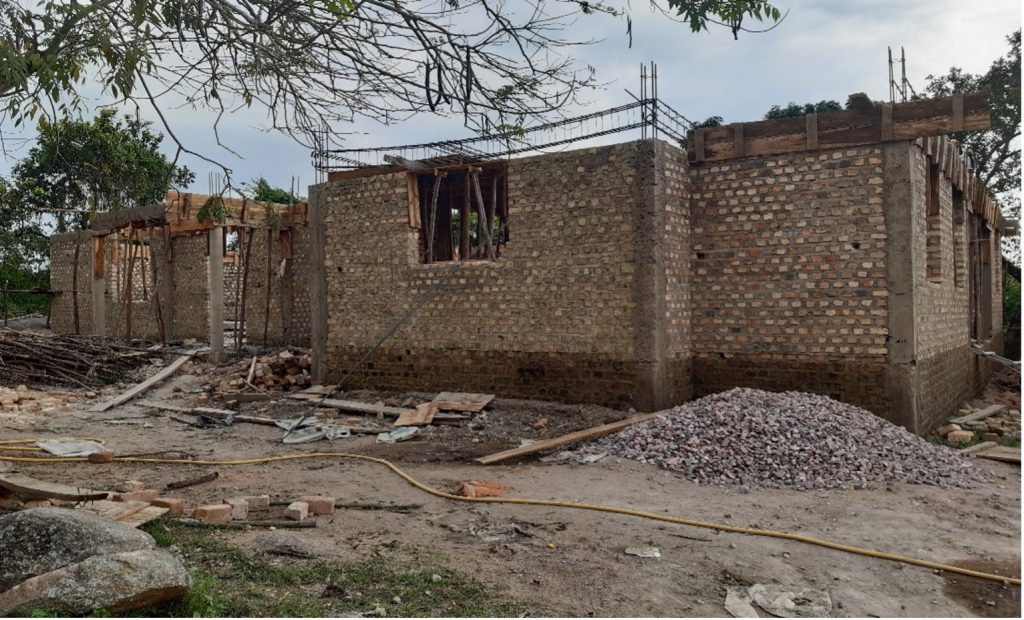
WORKS IN THE NEXT MONTHS Arbeiten der nächsten 6 Monate:
| PHASE II: From beam level I to wall plate Zwischendecke bis Wand Galerieebene |
| PHASE III: Roofing Dach |
| PHASE IV: Fixing shutters and flooring, internal & external plastering, Painting. Türen, Fußboden, Innen- und Außenputz, Anstrich |
Goal: A roofed structure in the second half of 2021 Geplant: Überdachter Rohbau in der zweiten Jahreshälfte 2021
Objective: Raise 118,965,000/= (One hundred eighteen million nine hundred sixty five thousand shillings) January to June 2021. Zielsetzung Spendengelder: 118,965 /= von Januar bis Juni 2021
The funds will be used to build up to wall plate and roofing the Building. Die Gelder sollen für die Wände sowie das Dach verwendet werden.
“A HUNDRED STEPS START BY ONE” Hundert Schritte beginnen mit einem einzigen


BUDGET UPTO ROOFING
| PHASE II | DESCRRIPTION Beschreibung | COST ESTIMATES geschätzte Kosten |
| From beam level I to wall plate | Bricks, sand, cement, steel and labour. Steine, Sand, Zement, Stahl und Arbeit | 18,000,000/= |
| PHASE III | ||
| Roofing Dach | Roofing materials and labour costs Dachmaterial inkl. Arbeit | 85,000,000/= |
| Un foreseen costs/inflation at 5% Unvorhergesehenes/Inflation 5% | 5,150,000/= | |
| ADMIN 10 % Baunebenkosten 10 % | 10,815,000/= | |
| SUM | 118,965,000/= | |
| PHASE IV | ||
| Other works weitere Arbeiten | Fixing Shutters (steel doors and windows with glasses), Internal and external Plastering, flooring and painting. Einbau Türen und Fenster, Innen- u. Außenputz, Fußböden und Anstrich | 100,000,000/= |
| Unforeseen costs and inflation Unvorhergesehenes/Inflation | 5,000,000/= | |
| ADMIN 10 % Baunebenkosten 10 % | 10,500,000/= | |
| SUM | 115,500,000/= |
Total cost Estimated: 234,465,000/= Million shillings
geschätzte Gesamtkosten: 234,465,000/= Million Shilling
SUPERVISIONS AND ACCOUNTABILITY: Aufsicht und Rechenschaftspflicht
Hope For The Needy Uganda will support the Church administration in supervision and monitoring of the works to ensure all funds donated locally and internationally are fully accounted for and quality work is done. Hope For The Needy Uganda wird die Kirchenverwaltung bei der Kontrolle und Überwachung der Arbeiten unterstützen um sicher zu stellen, dass alle lokalen und internationalen Spenden vollständig abgerechnet werden und die Qualität gesichert wird.
Justification for the Project: Projektbegründung:
- The former Church had become too small leading to the start of two Sunday Services at 8:00am and the other at 10:00am in 2019. Das ehemalige Kirchgebäude wurde zu klein, sodass zwei Gottedienste eingeführt wurden, einer um 8:00 und ein weiterer um 10:00 Uhr.
- The growing numbers: Kitokolo Christian community, project staff, the existing school population and the soon to open secondary school will equally add on the numbers qualifying the need for a bigger Church with capacity to seat at least four hundred congregants. Die steigenden Besucherzahlen: Die Kirchgemeinde Kitokolo, die Projektmitarbeiter, die bestehende Schülerzahl und die bald öffnende weiterführende Schule werden gleichermaßen die Zahlen erhöhen und damit den Bedarf einer größeren Kirche.
CURRENT PLACES OF WORSHIP Aktuelle für Gottesdienste genutzt Orte
- Class room at Kindegarten Block Ein Klassenraum im Kindergarten
- Primary School dinning hall. Speisesaal der Grundschule
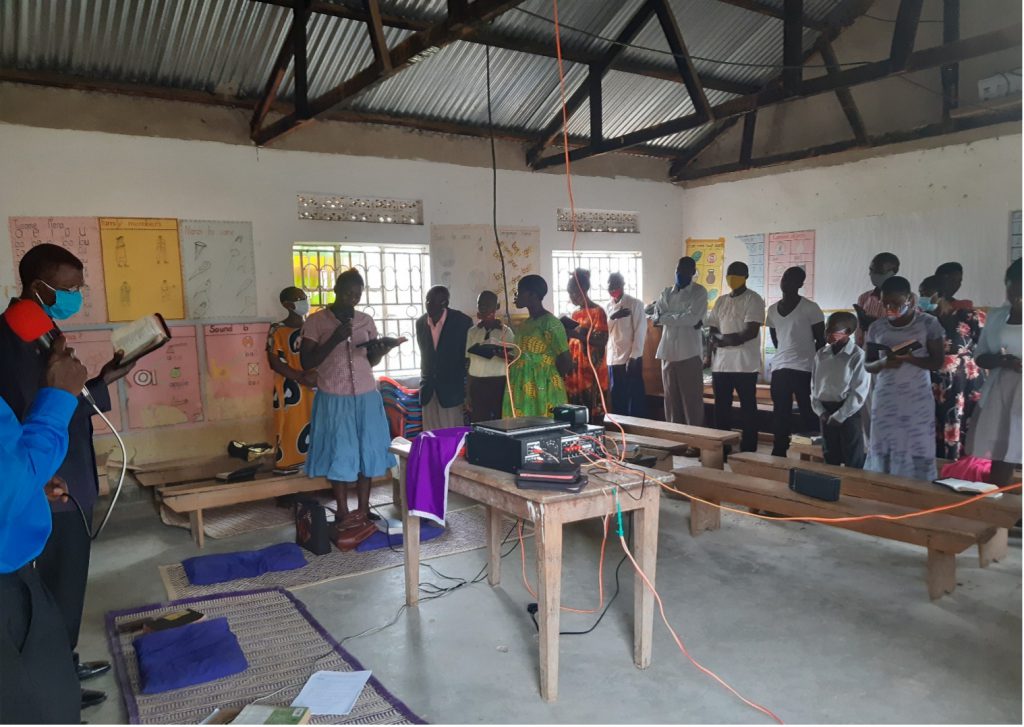
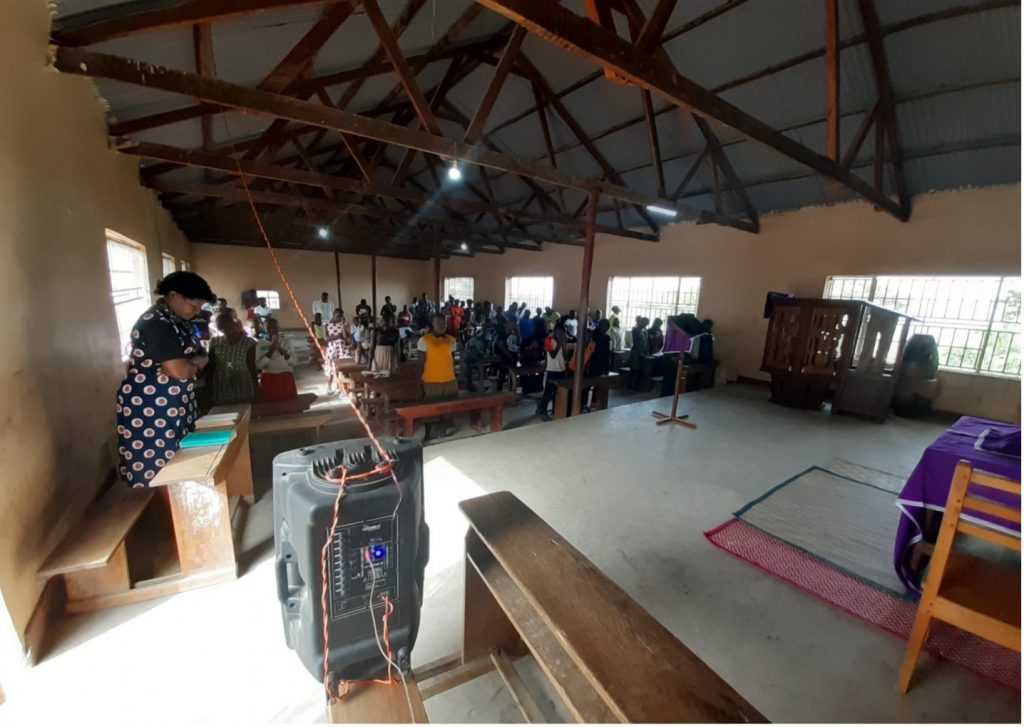
Request:Friends and partners to support All saints C.O.U construction work at Kitokolo Village, Kyamusisi parish, Mityana Diocese. Anfrage an alle Freunde und Partner: Bitte um Unterstützung der Bauarbeiten in Kitokolo, Kyamusisi Gemeinde, Mityana Dioszöse.
God’s blessings in the service of His children: Gottes Segen im Gottesdienst seiner Kinder
Contact: Annette Akankwasa
Hope For The Needy Uganda
P. O. Box 4329 Kampala, Uganda
Email: kitokoloproject@yahoo.co.uk
PROGRAMS ACTIVITY REPORT JANUARY TO DECEMBER 2020
EVENGELISM/SPIRITUAL MINISTRY
| ACTIVITY | ACTUAL ACHIEVEMENTS | |
| 1. | House to House Evangelism | 99 Homes visited including 6 bereaved families.2 youths and one elderly man gave their lives to Christ. |
| 2. | Discipleship | One-day Youth Retreat in February with a Theme “The lord is with you while you are with him…’’ 2chr.15:2 facilitated by 3 guest speakers. 516 out of the targeted 600 youths attended. 30-non-school going & 95 children below 12 years. 58 youths got saved.Baptism8 persons baptized in January. Prior training for God parents about spiritual nurturing of children. 3.Sunday services51 Sunday services conducted in homes with active participation of family members. The rest of the services were conducted on a public address system and some in church in October. 4.Group Fellowships and home cellsThere were 3 active home cell fellowships of about 4-6 adults each, plus the children. 10 children’s Home cell fellowship were formed within the parish with active participation in singing, bible reading, scripture memorization, as well as drama through skits. A parish Christmas children’s event was held.One youth fellowship was established with an attendance of 15-20 youths. |
| 5.Bible Study Conducted in fellowship meetings | ||
| 4. | Coordination meetings | 13 Meetings at both Parish and Arch-deaconry levels.23 church departmental meetings; some with the wardens, children’s ministers, zone leaders & building committee. |
| 5. | Supervision of the Church Development Projects | Maize harvesting and a total of 178 kg were harvested.Weeding of a 1-acre garden.10 visits made in the homes where 2 pregnant sows & 4 goats are kept.Two sows gave birth to 12 piglets some of which were sold to support church development. Others were given to the volunteer farmers and others as payment for male fertilisation. |
| 6. | 1st phase Church construction | Completed and this included demolition of the old structure and laying of the foundation for the new church. The second phase was also started on and taken up to gallery/1st beam level. |
EDUCATION
- KIZIBAWO PRIMARY SCHOOL
| ACTIVITY | ACTUAL ACHIEVEMENTS |
| 1.Workshops/Trainings | 2 senior staff (HM and Deputy), attended a one-week work shop on Early Grade Reading in January. Discussed were;-Mastering of letter Sounds.-Scheming and development of learning materials.-Inclusive methods of teaching |
| 2.Staff Recruitment | Interviewed and recruited 2 new teachers in January for the nursery section. |
| 3.Performance improvement strategies | Class tests and other examinations P.3-P.7 classes were given fortnight tests until March 2021. P.7 class did 6 sets weekly between October and December -special Term II. 98% of the general school enrollment (529) did the midterm 1 2020 exams.41 Candidates did end of term 2 exams. Routine supervision and book checking Staff supervision rated to 90% in conjunction with the lesson accountability. Majority scored 80% and above in the time reviewed. |
| 4.Keep a Child in school seminar | 200 pupils-12years and above engaged in seminars on causes, consequences and prevention of school drop outs by Kitokolo Health workers |
| 5. Renovation of staff quarters | 14 rooms & Head Teacher’s House; Works done: re-painting, ceiling construction, re-flooring and replacement of the old wooden windows and doors with new metallic ones. Solar system repairs, wiring and 3 batteries for replacement on classes. |
| 6. Academic Support to candidates during the lock down period | 41 candidates in 32 villages received learning materials organized by the school.Parents and candidates were guided on how to go about the materials and also cautioned about child protection issues since the children were staying longer at home. |
| Academic Support to children in P.1-P.6 | Out of 395 pupils, 72% received the work which was also graded. |
P.7 CANDIDATES PERFOMANCE IN PROGRESSIVE TERM 2 2020 TESTS
| Grade 1 | Grade 2 | Grade 3 | Grade 4 | Ungraded | x | |
| Set 1 | 00 | 00 | 4 | 9 | 28 | 3 |
| Set 2 | 02 | 06 | 10 | 13 | ||
| Set 3 | 05 | 16 | 21 | 06 | 02 | |
| Set 4 | 05 | 22 | 11 | 10 | 02 | |
| Set 5 | 05 | 22 | 11 | 10 | 02 | |
| Set 6 | O1 | 17 | 09 | 20 | 01 |
Results indicate improvement in performance. At least 5 students maintaining grade 1 in the respective 3 sets. The number of students with ungraded results was reducing from 28 to only one in the last set. The number of students attaining grade 2 increased from 0 to 22 in set 5.
P.7 CANDIDATES’ PERFORMANCE IN END OF TERM TWO 2020 EXAMS
| Grade | I | II | III | IV | U |
| No. | 07 | 14 | 10 | 18 | 1 |
7 students attaining grade 1, 1 ungraded.
REPORT ON DISTRIBITION OF LEARNING MATERIALS TO PUPILS FOR THE MONTH OF OCTOBER, NOV AND DECEMBER 2020
| ITEM | SET1 | SET2 | SET3 | SET4 | AVERAGE | |||||
| CLASS | SPONS | NON | SPONS | NON | SPONS | NON | SPONS | NON | SPONS | NON |
| P1 | 14 | 24 | 15 | 29 | 08 | 19 | 15 | 30 | 13 | 26 |
| P2 | 19 | 26 | 20 | 29 | 18 | 24 | 20 | 23 | 20 | 26 |
| P3 | 20 | 36 | 23 | 40 | 21 | 32 | 20 | 33 | 21 | 36 |
| P4 | 17 | 25 | 18 | 24 | 17 | 28 | 18 | 31 | 18 | 27 |
| P5 | 23 | 25 | 26 | 27 | 24 | 23 | 25 | 27 | 25 | 26 |
| P6 | 13 | 29 | 15 | 30 | 14 | 29 | 15 | 31 | 15 | 30 |
| TOTAL | 106 | 165 | 117 | 179 | 102 | 155 | 113 | 175 | 112 | 171 |
| GRANDTOTAL | 271 | 296 | 257 | 288 | 283 |
Out of 395 pupils we expected to provide learning materials, an average of 283 pupils received all the sets which makes 72% of the expected total number of pupils.
- KIZIBAWO VOCATIONAL INSTITUTE
| ACTIVITY | ACTUAL ACHIEVEMENTS |
| 1. Student’s Industrial training. | 57 students went to 9 different centers and did successfully complete their training, awaiting to graduate. |
| 2.Staff Recruitment | Interviewed 7 candidates, 3 recruited; 2 Agriculture and 1Tailoring instructors. |
| 3.Students enrollment | 166 students reported for term one 2020. 116 were new students.Agriculture = 8B.C.P =40Tailoring=64Hairdressing= 34MVT =20Increase in numbers was attributed to publicity & the new Agriculture course. 41 students reported in October and these were finalist. |
| 4. UBTEB and DIT Registration | 7 Students were registered for UBTEB and 43 for DIT exams. |
| 5.Counseling and guidance | 4 sessions conducted.One was attended by 160 students and 2 Instructors, facilitated by health workers from Bukuya HC IV with a major focus was on prevention of unwanted pregnancies.All Instructors plus 105 students were counseled and tested for HIV. 10 girls in the sponsorship program underwent pregnancy testing at the center. 5 were found pregnant.2 sessions were facilitated by the health workers at Kitokolo Health Centre and one by the Head of Programs. These were attended by female finalists. |
| 6.Gardening | 2 acres of land for maize planting were prepared by students.394kg of maize from February season plus 135kgs August Season harvested. |
| 7.Tree planting | 2 Teachers and 10 students attended a Tree planting workshop in February.All the students participated in the Tree planting exercise on project land. |
| 8.Renovation Works | Boys’ hostel and staff quartersRe-painting of the Boys’ hostel and a ceiling in 6 rooms accommodating staff completed by May.The hostel Verandah and that of the staff quarters re-fixedGutter fixing plus construction of two water tank bases. Two tanks were installed. Solar system3 batteries purchased for replacement at girls dormitory and office (2). |
| 9. Installations | -2 fire extinguishers to beef up safety against fire. -A water purifying system for drinking water at the institute. |
| 10. Compound | Additional works on the walk ways completed in Nov. |
- SECONDARY SCHOOL SINCE 2019
| 1.Construction | 1-A three classroom block roofed and plastered with steel doors and windows2-Started an administration block (offices, staff room), a library, one class room. The building is roofed. |
Works remaining include flooring, celling, plastering, fixing shutters and painting of the Admin block, fixing glasses and painting of the three classroom block.
- SPONSORSHIP:
(i) CHILD HAVEN
| NO | ACTIVITY | ACTUAL ACHIEVEMENTS |
| 1. | Enrollment | 4 children enrolled; 3 girls and 1 boy, receiving basic needs like beddings, Uniform, cases and school requirements |
| 2. | Farm Projects | 3 Cow with a calf born in February.3 goats, 2 male goats born.2 pigs sold at 700,000/=Local birds increased: 7 Hens, 1 cock and chicks. |
| 5. | Visiting Teams | Five visitors from Amali. eV in February. Children received gifts, wrote letters for their sponsors. |
| 6. | Repairs and renovation | -Toilet in the guest wing.-2 Pit latrines emptied-Replacement of 5 solar lamps. |
| 7. | Care giver participation. | Cleaning and gardening by 25 caregivers. Bushy compound, pruning of the banana plantation and weeding. |
| 8. | School and hostel support | All the children received personal hygiene items throughout the year and scholastic materials (books, pens and pencils)20 children received new day wear uniforms.2 received new Sunday wear uniforms10 Received new pairs of shoes20 received new pairs of stockings |
| 9. | Medical support | Sick children received treatment. Common conditions: malaria and upper respiratory infections. |
(ii) GENERAL SPONSORSHIP
| NO | ACTIVITY | ACTUAL ACHIEVEMENTS |
| 1. | Letter writing. | 90% of the sponsored children wrote routine letters to their sponsors and these were delivered through Feb Visitors. |
| 2. | School Support | School fees and scholastic materials |
| 3. | New enrollments | 40 children enrolled into sponsorship receiving fees, mattresses and blankets. |
| 4. | School visits. | Children in Secondary School & other institutions visited in February. |
| 5. | Home Visits | – Over 70 visits were made including pre and post sponsorship visits. – 100 visits were made during the lock down period for updates on children’s personal Information and to assess social-economic and health status as well as academic engagement. |
| 6. | Caregiver meetings | 5 meetings were held in communities to monitor the beans project as well as sensitize caregivers on child protection and academic support. |
| 7. | Monitoring of IGAs | A total of 3,788kgs of beans received from 2 seasons 2020. 1,511Kgs were sold and money used to purchase more Beans. 102 families were engaged receiving all together 2,686kg for planting. |
| 8. | Centre days | 3 Age graded centre days were held under the Theme; LIVING A PURPOSEFUL YOUTH LIFE, facilitated by 3 social workers.238 out of 289 youths attended. Areas of focus were;Scripture sharing and memorization.Discovering own potential, strengths and talents.Seven habits of highly effective people. (For the older age group).Sexuality and Reproductive health.Personal hygiene.Senior citizen advice. Altar Call |
HEALTH CENTRE
| ACTIVITY | ACTUAL ACHIEVEMENTS | |
| 1. 111 | Community Health Outreaches | 10 Sessions held with antenatal and post-natal mothers. Areas addressed;Importance of hospital delivery and attending antenatal checkups. In attendance were 22 mothers.112 participants from 4 villages educated on Good feeding habits for children below 5 years.2. Signs, symptoms and preventive measures for Covid -19 attended by 80 participants from 1 village. In Partnership with Mityana Diocese- UPMB Program on Non Communicable Diseases was started; 2 outreaches were conducted in 2 villages and 50 people were screened. 8 were diagnosed with hypertension and started on medication. A general medical camp: 220 patients received pre-paid treatment for malaria, cough, hypertension, skin infections and urinary tract infections. A Dental camp: oral education and screening of 166 clients. 152 had their tooth extracted and treatment given. Community health fund: 71 Very needy clients received a waiver on their medical bill debts, 29 postpartum mothers paid less by 15,000/= of their delivery bills ranging between 30,000/= and 50,000/=. |
| 2. | School health Education under “Keep a girl child in school” program. | 3 Primary schools visited and 330 pupils sensitized on the causes, consequences and prevention of school dropout. |
| 3. | Malnutrition Program | 29 beneficiaries received nutritional supplements on a monthly basis. Had 24 children in 2019.A Practical demonstration on food preparation was organized for 26 care givers, facilitated by 2 health workers. The prepared food was served to the children.Home visits: All beneficiaries were visited and 7 had at least started small projects including poultry rearing and small green vegetable gardens.13 Children were discharged after they had attained their normal weight, MUAC for age.Provision of treatment: All the children received pre-paid medical treatment with such conditions as Upper respiratory tract infections and Malaria.A Demonstration garden (quarter an acre on HONU land) was prepared in May by 15 care takers for planting vegetables. |
| 4. | Elderly Support | Home visits; 30 elderly persons were visited mainly to assess their housing and health status. House renovation. Two houses were renovated by replacing the leaking iron sheets and completion of a half way built house.Construction of houses. One room permanent house built for two elderly ladies in Kimbejja village. Provision of medical care. 27 Beneficiaries accessed free medical care. Common conditions were hypertension, Malaria, Upper Respiratory Tract Infections plus Peptic Ulcer disease. |
| 5. | Trainings | 4 health workers and staff in management attended Trainings (6)facilitated by Life Net Uganda. Areas covered: Conflict ResolutionImportance of attending Antenatal.Vaginal bleeding, and Post-partum hemorrhage.Control and Labor monitoring using a pantographBasics about the Covid-19 management.Financial management. A training for management Committee members on their roles and responsibilities was organized and attended by 5 members on the committee plus staff in management (7) A training on Assessing children with disability was organized by UNICEF & COWADSA at Kassanda District, attended by 2 staff and 5 VHTs. 10 children have so far been identified and referred for treatment through COWADSA. 2 staff attended a work shop on New consolidated guidelines for HIV testing and counseling 2020. Two Internal workshops organized by Clinton Health Access Initiative (CHAI) in Partnership with Life-net International were organized to assess the health worker’s knowledge on family planning. 10 participants attended including staff and VHTs. Two health workers and 5 VHTs attended a 4 days training on management of Non-Communicable diseases supported by UPMB. UPMB through its advocacy program on Non-Communicable Diseases also offered to sponsor a Radio program that will run for 7 months where Kitokolo Health workers will be part. |
| 6. | Home Visits | 6 Visits focusing on improved sanitation were done in 6 villages reaching out to 107 households. |
| 7. | Re-Equipping | -7 BP machines, 5 Aprons and 2 T-shirts from UPMB. -A temperature Gun Thermometer, 5L of liquid soap, 2 boxes of Surgical masks and Disposable gloves from Life-Net International.-A brand new laptop from Life-Net International. -A Hand washing equipment and purifying water system through Kassanda district. – 4 health staff acquired new uniforms from the facility own funds |
| 8. | Health Insurance | Through net-working with Save for health Uganda SHU, the health center catchment area expanded to villages like Bujjayu in Kalangalo Sub-county. 141 beneficiaries accessed treatment from the facility covered under community health insurance schemes. |
| 9. | HIV testing and counseling | 69 clients were counseled, tested and 2 were found positive. These were referred to Kassanda Health Centre IV. |
| 10 | Renovations | The In charge’s house was given a face lift; a ceiling was fixed, the floor and verandah re-done, wooden windows and doors replaced with metallic ones and the block re-painted. |
HEALTH CENTRE ATTENDENCE: Below is a table showing Disease Prevalence Rates in 2020
| 0-28 Days | 29 days-4 Years | 5-9 Years | 10-19 Years | 20+ | ||||||
| M | F | M | F | M | F | M | F | M | F | |
| Malaria | 229 | 259 | 145 | 149 | 182 | 238 | 256 | 387 | ||
| Typhoid Fever | 1 | 0 | 6 | 6 | 10 | 8 | 16 | 27 | ||
| Acute Diarrhea | 27 | 38 | 5 | 6 | 6 | 2 | 3 | 2 | ||
| Urinary tract infections | 9 | 11 | 7 | 30 | ||||||
| Other Sexually transmitted Infections | 5 | 6 | 9 | 13 | ||||||
| Common Cough-Cold | 83 | 93 | 34 | 54 | 50 | 69 | 71 | 113 | ||
| Pelvic Inflammatory Disease | 6 | 11 | ||||||||
| Gastro-Intestinal Disorders | 1 | 8 | 10 | |||||||
| Allergic Conjunctivitis | 5 | 1 | 4 | 6 | ||||||
| Skin Diseases | 9 | 11 | 15 | 18 | 3 | 6 | 7 | 4 | ||
| Hypertension | 33 | 45 |
Malaria prevalence wasmuch higher than the other conditions, the highest rates being among females above 20 years and female children below 4 years.
Cases diagnosed with hypertension increased compared to 2019 due to the current program for Non Communicable Diseases. The program emphasizes screening every individual above 18yrs attended to.
Immunization services.
Immunization of children below 5yrs at the Health Centre static and during outreaches.
| Name of immunization site | Number of children immunized |
| Kitokoklo | 914 |
| Bujonjo/ Namiryango | 794 |
| Kyetume | 367 |
| Kijwanganya | 574 |
| Kalongo | 405 |
| Lwawona | 70 |
More mothers accessing the service at the facility compared to the outreach sites. Bujonjo and Namilyango site had the highest number of attendants among the outreach sites.
An immunization outreach was established in Lwawona due to high demand for the service.
Girls Between 9-11 years were immunized against cervical cancer.
Child immunization days were carried out in the months of April and October (deworming tablets and vitamin A) were administered.
Maternity services.
| Services offered | 10-19years | 20-24years | 25years &above |
| Deliveries | 11 | 24 | 38 |
| Antenatal care | 53 | 114 | 181 |
| Family Planning | 35 | 76 | 94 |
The number of deliveries at the facility is still very low compared to the number that access antenatal care services.
INCOME GENERATION
- MILLING MACHINE:
Income and Expenditure of the Milling Machine for 2020
| ITEM | Income | Expenditure |
| 20,613,700/= | ||
| Employment Costs | ||
| N.S.S.F | 570,000/= | |
| Salaries | 3,950,000/= | |
| Medical | 96,000/= | |
| Lunch | 1,241,500/= | |
| Identity cards | 10,000/= | |
| Operations | ||
| Contribution to cashier | 50,000/= | |
| Fuel +Lubricants | 5,831,000/= | |
| Maize Seeds | 8,460,000/= | |
| Milling fee | 2,500,000/= | |
| Repairs and Maintenance | 6,973,000/= | |
| TOTAL | 20,613,700/= | 29,682,200/= |
Surplus/Deficit= (8,788,381/=) Milled Items include Maize, Cassava and sorghum.
Poor performance of the machine attributed to closure of schools which were the biggest customers, low quality of the maize flour and frequent break down of the machine were the major challenges.
Most of the income comes from maize milling as compared to other items.
- CANTEEN
Stocking of the Canteen was done on a quarterly basis although sales were greatly affected by schools’ closure.
Income and Expenditure of the Canteen for 2020
| ITEM | Income | Expenditure |
| 14,987,800/= | ||
| Employment Costs | ||
| N.S.S.F | 829,592/= | |
| Salary | 2,370,720/= | |
| Medical | 35,000/= | |
| Lunch | 760,000/= | |
| Identity cards | 5,000/= | |
| Operations | ||
| Contribution to cashier | 50,000/= | |
| Administration fee | 100,000/= | |
| Audit fees | 240,000/= | |
| Bank charges | 174,300/= | |
| Purchases | 12,430,400/= | |
| TOTAL | 14,987,800/= | 16,994,992/= |
Surplus/Deficit= (1,320,492/=)
Poor performance attributed to the closure of schools being the biggest customers.
Commonly desired items are home consumables and snacks.
INSTITUTIONAL CAPACITY BUILDING
| ACTIVITY | ACTUAL ACHIEVEMENT |
| Governance & Leadership Meeting Policy Documents Financial Management | -4 Board meetings including the AGM: – discussing policy matters & approving program activities. -17 meetings with Heads of Departments:- planning, budgeting, assessing & evaluating program implementation -Annual targets set and reported on quarterly In draft form are HR Manual & HONU articles and Memorandum of understanding under review. -Audit 2019 report approved by the Board & at the AGM-Quarter financial report, only two were reviewed at Board level. |
| Partnership & Net working | -Meetings with partners within and outside Uganda: Diocese, UPMB, District, SHU, Life Net Uganda and German partners.-Maintained HONU webpage though not so actively used |
| Monitoring and Evaluation | -internally reviewed 2 years and half of the five year strategic plan- 2021 operational plan and Budget approved by the Board. |
NB: Infrastructure developments are reported on under departmental program.
Departmental challenges.
- Evangelism/Spiritual Ministry
- Limited man power to implement the planned programs.
- High illiteracy levels in the community limiting activities such as Bible study.
- Limited involvement of men and youths in church activities
- Education
- Kizibawo Primary School
- Security threats due to non- fenced school premises plus security guards high turnover.
- Mechanical fault for both the printer and the photo copier inconvenienced the smooth running of the COVID 19 Holiday study work.
- Lack of means of transport to ease school activities.
- Kizibawo Vocational Institute
- Limited man power in some courses like BCP and Administration
- Total dependence on fees which is very low compared to the demands of the institute.
- Lack of a strategic show room for products such as those from tailoring.
- Lack of electric hydro power for administration and course enhancement.
- Remoteness of the institute
- Sponsorship
- Limited man power to handle the social work
- Students and pupils being out of school
- Limited contact hours with the children and their caregivers
- Limited supervision of economic empowerment programs.
- Health Centre
- Lack of hydro-electric Power to aid running of equipment especially in the laboratory.
- Un-Fenced facility premises.
- High poverty levels in the area limiting affordability of critical tools like mama kits for delivering mothers and failure to meet costs of treatment even when they are subsidized.
- Poor involvement of men in health related issues concerning their families like family planning, immunization, and antenatal, HIV testing and general checkups.
- Lack of a Children’s ward and a substantial laboratory.
- Income generating Activities.
- Milling Machine
- Low quality products attributed to a diesel engine and type of mesh used.
- Lack of protective gears.
- Frequent machine breakdown making the cost of maintenance and repairs so high.
- Lack of an alternative smaller machine for Cassava, millet and sorghum.
- Canteen
- Lack of a cooking shelter and firewood store
- Work Overload during school days.
General Recommendations
- Filling critical manpower gaps identified in 2020 and taking on volunteers.
- Intensify community empowerment programs to overcome high poverty levels and increase community involvement and ownership of project programs.
- Priotize general fencing of all project premises to beef up security.
- Continue lobbying for hydro-electric power extension.
- Introduce adult literacy classes
- Special programs targeted at sensitizing men to increase their involvement.
- Revision of budgets for sustainability projects in case normal schooling does not resume.
Conclusion
Despite the effects of the COVID 19 Pandemic, some project programs kept on running and a lot was achieved especially under health, Administration and Infrastructural development. Although the education and IGA departments were greatly affected, efforts to keep the primary children academically engaged kept the schools going. Support to Vocational and Secondary students not in school proved hard in the prevailing circumstances and this will require closer attention in the future.
We appreciate God for the team work behind 2020 achievements.
Acknowledgement:
Board of Directors and Management committees for the Guidance and approval of programs sustaining activity implementation &
To all HONU partners for the financial and support in kind received in 2020.
Heads of Departments:
- Mr. David Rwakijuma Evangelism
- Mr. Ntege Yoweri Primary School
- Mr. Paul Senyonga Vocational Inst.
- Ms. Eron Nakasita Health
- Ms. Justine Muwanga Accounts/IGAs
- Mrs. Nassozi Sarah Mwesigwa Assisting in the sponsorship
Compiled by: signed by:
…………………………………
Nassozi Sarah Mwesigwa Annette Akankwasa
H.O.Ps Director.
Filed: 24THFEBRUARY 2021
Hilfseinsatz in Kitokolo Februar 2020
Grund der Reise:
- Besuch des Entwicklungsprojektes Kitokolo in Uganda
- Besichtigung und Kontrolle des Projektes
- Erfüllung des Vereinszweckes
Termin:
25.02.2020-11.03.2020
Teilnehmer:
Vereinsmitglieder: Barbara Siebert, Bernd Schettler, Heidi Schettler und Angela Oppelt, Philipp Oppelt
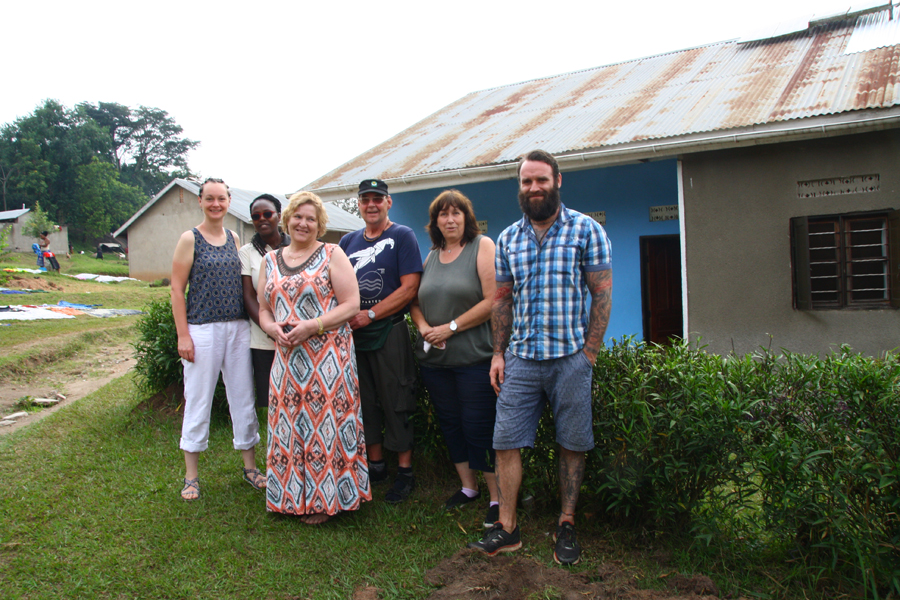
Anreise:
Aus Grünbach, Adorf, Carlsfeld und Magdeburg, ab Flughafen Berlin Tegel Abflug 11.35 Uhr mit Fluggesellschaft Türkish Airlines: Zwischenlandung in Istanbul, Ankunft in Entebbe 3.55 Uhr, Übernachtung in Kampala: in „Charlies Haus“
Hilfsgüter:
Im Rahmen unseres Reisgepäckes konnten wir folgende Hilfsgüter mitnehmen:
Decken, Bettwäsche, Handtücher, Schreibmaterial, Kleidung für Männer, Frauen und Kinder verschiedener Altersklassen, Babysachen, Schuhe, Spielsachen, Süßigkeiten, Medikamente, Instrumente/ Geräte für Zahnbehandlungen (Spende einer Zahnärztin aus Greiz), Hygieneartikel, Patengeschenke, 7 Laptops (Spende „Labdoo“) etc.
Unterbringung: In
Kitokolo wohnten wir im „Marquardt-Gästehaus“ und im „Child Haven“
Projektbesuch:
1.Einkauf
Es wurden Hilfsgüter in Kampala, Mityana und Bukuja eingekauft u.a.:
200 Päckchen Waffeln
200 Päckchen Milch
25 Pack Sojamehl
200 kg Zucker
2 Kartons Seife
1 Karton Salz
Die Dinge wurden an Patenkindern, Schulen, Kinderheim und bedürftige Familien im Dorf ausgegeben.
2. Kinder- und Jugendtag
Der erste Kinder- und Jugendtag mit dem Titel“ One Day Youth Retreat in Kitokolo-Church in Uganda“ fand an einem Samstag statt. Alle Kinder und Jugendliche ab 10 Jahre der Gemeinde waren eingeladen. Es kamen ca. 500 Teilnehmer. Der Tag wurde vom AMALI e.V. finanziell unterstützt.
Auf dem Programm standen Anbetung und Lobpreis, Gebet, Verkündigung von Gottes Wort, Zeugnisse, Gruppendiskussionen und gemeinsames Essen.
Der Missionstag wurde von der Kitokolo- Kirchenleitung organisiert. Dazu wurden drei externe Referenten eingeladen. Es war ein segensreicher Tag und es besteht der Wunsch diesen einmal jährlich im Februar abzuhalten.
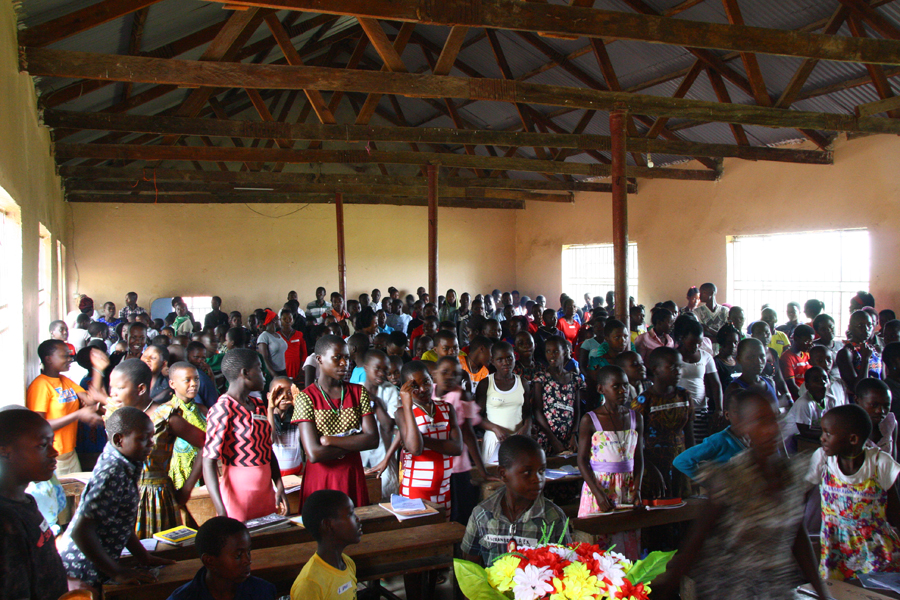
3. Kirchgemeinde
Am Sonntag fanden in der Kirche 2 Gottesdienste nacheinander statt. Zu jedem Gottesdienst war die Kirche voll. Parallel findet die Sonntagsschule für Kinder im Speisesaal statt. Die Gemeinde plant eine neue, größere Kirche zu errichten, wo alle Gottesdienstbesucher Platz finden. Besonders viele Jugendliche und Lehrer von den Projektschulen nehmen jeden Sonntag am Gottesdienst teil. Und die Zahl wächst weiter. Die ersten Baumaterialien wurden bereits angeliefert. Die Bauarbeiten sollen bald starten und schrittweise durchgeführt werden. Man ist noch dabei, verschiedene Angebote von Baufirmen einzuholen.
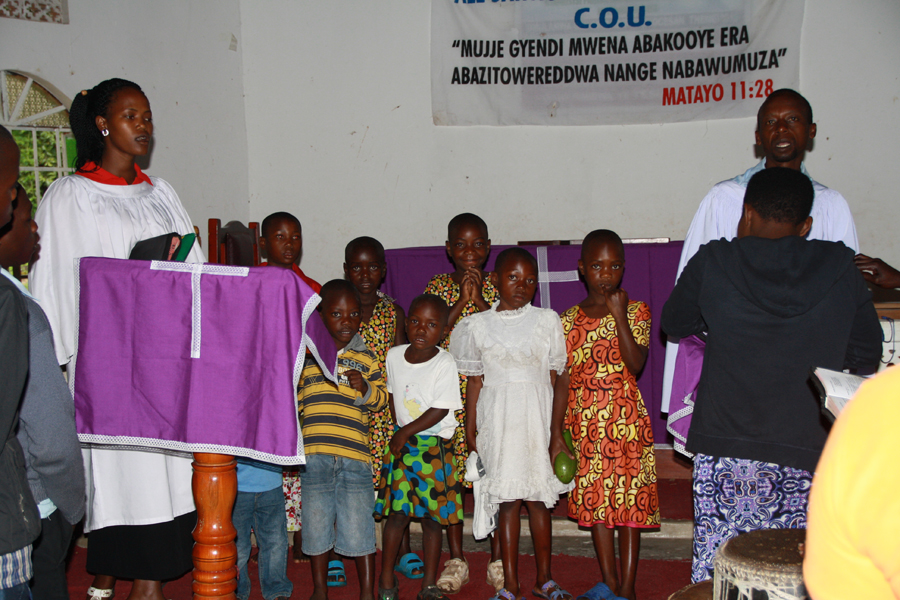
4. Tag für unterernährte Kinder
Am 2.März 2020 ist dieser Tag angesetzt. Er findet im 14tägischen Rhythmus statt. Um 9 Uhr soll es losgehen, da sieht man erst nur die Schwester, welche die Feuerstellen vorbereitet. Nach und nach kommen Frauen mit Kindern auf dem Rücken und an der Hand, sowie etwas Gepäck, meist nur in ein Stück Stoff (wie ein Sack) gewickelt, teilweise von sehr weit hergelaufen. Die meisten Frauen sind vermutlich die Großmütter der Kinder. Es ist hier oft so, dass die Kinder den Großeltern, die nur selten noch zu zweit sind, überlassen werden, da die Mütter aus verschiedenen Gründen nicht in der Lage sind sich zu kümmern.
Einen großen Karton mit Sojamilchpulver und einige kleine Plüschtiere nehme ich mit zum Platz. Darüber wird richtig gejubelt und die Frauen freuen sich fast mehr über die Plüschtiere, als die Kinder, die schüchtern und zurückhaltender sind, manche haben richtig Angst vor Weißen.
Wir sitzen im Freien auf Holzbänken im Schatten. Die Kleinen sitzen oder liegen meistens auf Decken.
Der Krankenpfleger und die Schwester fangen vor den Frauen und einem älteren Mann, an zu sprechen. Es geht um die Hygiene, gesundheitliche Probleme bei Säuglingen und um entsprechende altersgerechte Ernährung.
Es sind 14 Frauen, ein Mann und jeweils ein bis drei kleine Kinder. Sie hören gespannt zu. Einige Kinder sind apathisch und sitzen nur ruhig da. Das ist nicht normal für ein gesundes afrikanisches Kind, denn sie müssen von klein auf mithelfen und weit laufen und strotzen meistens vor Energie. Andere sind für ihr Alter viel zu klein, fast wie kleinwüchsig. Dicke Wasserbäuche, die auf Würmer hinweisen sind nicht dabei, die wurden schon behandelt.
Der Pfleger geht dann gleich weiter. Er und noch eine Schwester müssen in der Krankenstation den Betrieb am Laufen halten. Hier sitzen stets Leute im Wartebereich.
Die Schwester kocht gemeinsam mit den Frauen ein gehaltvolles Sojamilchpulver, welches mit etwas Margarine zu einer cremigen Suppe verarbeitet wird. Dazu gibt es ein Gebäckstück, eine kleine Banane und ein gekochtes Ei.
Das ist ein Frühstück, welches sich nur wenige leisten können, da bleibt nichts übrig. Inzwischen sind es 40 Leute geworden.
Weiterhin stehen auf den drei Feuerstellen, zweimal Bohnen (einmal direkt für Kleinkinder), Matoke (Kochbananen), Soße mit kleinen getrockneten Fischen und Wasser mit Kräutern (Tee). Gewürzt wird mit Salz, Zwiebeln, Tomaten und vielen Kräutern. Das gibt es dann zum Mittagessen und man staunt, welch große Mengen alle essen können.
Mehrere Wasserkanister, Spülmittel und Schüsseln stehen zum Händewaschen und Geschirr abwaschen bereit und es wird auch von der Schwester immer wieder erklärt, wie wichtig dies ist und was besonders bei Babys zu beachten ist, um Krankheiten zu vermeiden. Danach legen sich einige auf die Wiese zum Ruhen, andere unterhalten sich ganz angeregt.
Eine Frau wirkt sehr krank und ihre Tochter kümmert sich total gut um das einjährige Kind, welches aber jünger aussieht. Auf meine Frage, ob sie nicht auch in die Schule gehen müsste, finde ich heraus, dass sie mit ihren acht Jahren die Älteste von 7 Kindern ist und die Geschwister versorgen muss. Die Mutter war mit dem achten Kind schwanger. Das Kind starb im Mutterleib und wurde herausoperiert. Dass größere Kinder ihre kleinen Geschwister versorgen, ist hier ganz normal, wie viel Verantwortung und Leistung manchen Kindern zugemutet wird. …in Deutschland undenkbar.
Beim Aufräumen packen fast alle mit an. Nach und nach machen sich alle auf den Heimweg. Die kranke Frau wird mit ihren beiden Kindern mit einem Boda Boda (Motorrad) nach Hause gefahren. In Uganda ist es ein normales Bild, wenn die ganze Familie auf einem Boda Boda sitzt, plus Gepäck.
Für die Leute, die an diesem Tag teilgenommen haben, war es wie ein Festtag, so viel Essen und nicht arbeiten müssen, denn um für die Familie zu kochen, muss man erst etwas vom Feld holen und bearbeiten, zwischendurch Neues anbauen usw. Die Frauen haben den ganzen Tag zu tun und sind dazu meistens allein auf sich gestellt.
Es war ein gelungener Tag für alle. (von Barbara Siebert)
5. Patenkinder
Es wurden die Patenkinder in den Schulen (Primary School und Vocational Institut) im Kitokoloprojekt, und in den weiterführenden Schulen (Secondary School) in Bukuja und in Kiryokya besucht.
Viele Jugendliche haben ihre Ausbildung beendet und konnten ins Berufsleben entlassen werden. Andere haben die Grundschule absolviert und besuchen nun eine weiterführende Schule oder eine Berufsschule.
Bei einigen wenigen Kindern müssen noch verschiedene Dinge abgeklärt werden. Verschiedene Kinder wurden zu Hause besucht, um das familiäre Umfeld und ihre Lebensumstände genauer kennenzulernen.
Es wurden viele neue Kinder ins Patenkinderprogramm aufgenommen.
6. Internate- Boarding Section
Im Projekt gibt es vier Internate:
- für die Jungen
in der Grundschule - für die
Mädchen in der Grundschule - für die Jungen
in der Berufsschule - für die
Mädchen in der Berufsschule
- Jungeninternat
Grundschule (Primary boys boarding section):
Das Jungshostel wurde 2018/ 2019 für 42 Jungs errichtet. Das Hostel wird von einem Lehrer betreut und ist gut organisiert und gepflegt. Durch die wachsende Schülerzahl ist die Kapazität jedoch schon ausgeschöpft.
Teilweise schlafen schon jetzt 2 Kinder in einem Bett. Es sollte noch ein zweites Gebäude mit 42 Plätzen gebaut werden.
- Mädcheninternat
Grundschule (Primary girls boarding section):
Eine ähnliche Situation besteht im Mädchenhostel. Hier werden dringend neue Betten benötigt. Für die Zukunft wäre die Planung eines neuen Mädchenhostels auf dem Gelände der Grundschule sinnvoll. Aufgrund der Nähe zum Jungshostel müsste dieses jedoch eingezäunt werden. Auch hier sollten ca. 84 Plätze angestrebt werden.
- Jungeninternat
Berufsschule (Vocational Institut boys boarding section):
Für die Jungen der Berufsschule stehen zwei ausreichend große Schlafräume zur Verfügung. Jedoch fehlen Betten. Viele Schüler schlafen auf dem Boden. Aktuell sind 40 Jungen im Internat, Tendenz steigend. Für mindestens zehn stehen keine Betten zur Verfügung.
- Mädcheninternat
Berufsschule (Voc. Institut girls boarding section):
Auch das Mädcheninternat für die Berufsschülerinnen ist überfüllt. 67 Mädchen sind 3 Räumen untergebracht. Einige schlafen zu zweit in einem Bett. Eine Erweiterung des Internates sollte durch einen seitlichen Anbau erfolgen.
Als Sofortmaßnahmen werden 19 Stahlbetten gekauft.
7. Vocational Institut
Das Vocatinal Institut wurde 2018/2019 umfangreich erweitert. Es ist ein attraktiver Campus entstanden, der den Schülern sehr gute Lernverhältnisse bietet. Aktuell lernen hier 156 Schüler in folgenden Kursen: Schneiderei, Friseur/ Cosmetik, Maurer, Mechaniker, Landwirtschaft.
Für die Wartung der Nähmaschinen wurde eine Spende übergeben.
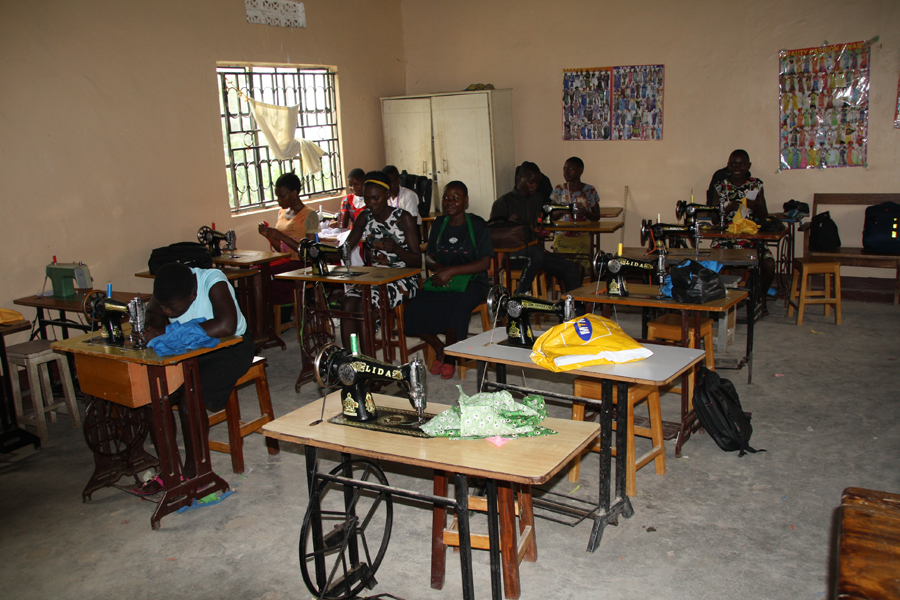
8. Maismühle
Die Maismühle wird von der Bevölkerung angenommen und arbeitet kostendeckend. Besonders nach der Erntezeit ist sie gut ausgelastet.

9. Kizibawo Grundschule
Die Qualität der Grundschule hat sich im letzten Jahr bedeutend verbessert. Die Schülerzahl ist wieder ansteigend.
Es ist der Wunsch für die Schulspeisung Zucker zu verwenden. Dieser soll in den Frühstücksbrei verarbeitet werde. Deshalb wird sich das Schulgeld wie folgt erhöhen:
Baby-P4: 10.000 UGX/Term
P5- Voc. 20.000 UGX/Term
Künftig werden noch mindestens 4 Klassenzimmer benötigt.

10. Child Haven / Kinderheim
Das Kinderheim ist voll belegt. Die Kinder werden hier sehr gut betreut. Für den Sozialarbeiter Ben wurde vor ca. einem halben Jahr Sarah eingestellt. Sie arbeitet zur Hälfte für das Kinderheim und zur Hälfte in der Administration.
Es soll jedoch wieder ein Sozialarbeiter (in) angestellt werden.
Aus Sonderspenden werden für jedes Kind Regenjacken angeschafft.
11. Krankenstation
Besonders hilfreich und nützlich ist die Unterstützung von Medikamenten für die Dorfbevölkerung. Hierfür werden bedeutend mehr Gelder benötigt um den Bedarf abzudecken. Ebenso sollen dieses Jahr wieder Zahnarztbehandlungen durchgeführt werden. Zu diesem Zweck wurden Spenden für medizinisches Gerät übergeben.
12. Baumprojekt
Im Rahmen des Projektes wurden vor Ort ca. 200 Bäume gekauft, darunter verschiedene Arten von Mangobäumen, Orangenbäume und Musizibäume (Holz- und Schattenspender). Zum Einen wurden die Bäume auf dem Gelände des Projekts gepflanzt, zum anderen rund um das Kinderheim Child Haven und weitere Bäume wurden an drei Schulen in der nahen Umgebung gespendet.
Sämtliche Bäume auf dem Projekt und in der Nähe des Kinderheimes wurden mit Hilfe der sieben Berufsschüler der Agriculture Class und deren Lehrer zusammen gepflanzt. Am Tag vorher wurde festgelegt, wo die Bäume gepflanzt werden sollen und die Pflanzlöcher wurden vorbereitet. Die Mango-, Orangen- und Musizibäume wurden dann vorbereitet, gewässert und über das gesamte Areal verteilt in die Löcher gepflanzt. Mehrere Kinder des Projektes verfolgten die Arbeiten begeistert. Auch wir fünf Besucher aus Deutschland und Annette pflanzten fleißig mit. Die frisch gesetzten Bäume wurden noch gewässert, im Bereich von Child Haven mit Hilfe des dort angelegten Brunnens. Danach wurden sie mit Stroh abgedeckt, um die jungen Bäume vor der Sonne zu schützen. Die Obstbäume sollen zukünftig von Schülern und Lehrern gepflegt werden um sie anschließend ernten zu können.
Die drei Schulen nahmen die gespendeten Bäume freudig und sehr dankbar entgegen. Zusammen mit den Schulleitern wurden sie in die bereits vorbereiteten Löcher zusammen gepflanzt. Dass zwei Besucher aus Deutschland beim Pflanzen mit halfen wurde von den Kindern begeistert verfolgt.
Weiterhin wurden ca. 50 Moringabaumsamen gesät. Zusammen mit der Agriculture class wurde im schuleigenen Garten ein Anzuchtbeet vorbereitet. Der Lehrer demonstrierte, wie man mit Hilfe eines Stocks die richtigen Abstände abmisst und die Schüler setzten die von uns vorbereiteten Samen in das Beet. Es wurde gewässert und die Samen ebenfalls mit Stroh abgedeckt, um sie vor der Sonne zu schützen. Die Samen wurden mit sehr viel Freude angenommen und das gemeinsame Pflanzen mit den Besuchern aus Deutschland sehr geschätzt. Die Klasse übernimmt die Pflege der Samen, die inzwischen zu kleinen Pflanzen gewachsen sind. Der Moringabaum ist vielseitig verwendbar und soll vom Projekt genutzt werden.
Außerdem wurde ein Workshop angeboten. Dazu wurden Lehrer aus umliegenden Schulen eingeladen, was auch dankbar angenommen wurde und ca. 30 Leute versammelten sich in einem Raum der Berufsschule. Der erste Vortrag wurde von Angela Oppelt über den Wald allgemein sowie die Nachteile der Abholzung und die Vorteile der Aufforstung gehalten. Der Lehrer der Agriculture class hielt anschließend einen Vortrag über Obstbäume, deren Anbau und Pflege. In einer Pause wurde sehr lebhaft diskutiert und die gespendeten soft drinks genossen. Abschließend hielt Angela noch einen Vortrag über die vielen Verwendungsmöglichkeiten des Moringabaums. Die Anwesenden kennen den Baum zwar, aber nutzen ihn nicht und sind überrascht, dass man sowohl Blüten, Samen, Blätter und auch Wurzeln als Nahrungsmittel verwenden kann. Ein Lehrer brachte sogar extra einen Moringazweig mit, der von allen begutachtet wurde. Es wurde noch fröhlich diskutiert und der Workshop insgesamt sehr positiv aufgenommen. Für weitere Workshops sprachen sich die anwesenden Lehrer und auch Schüler sehr aus. (von Angela Oppelt))


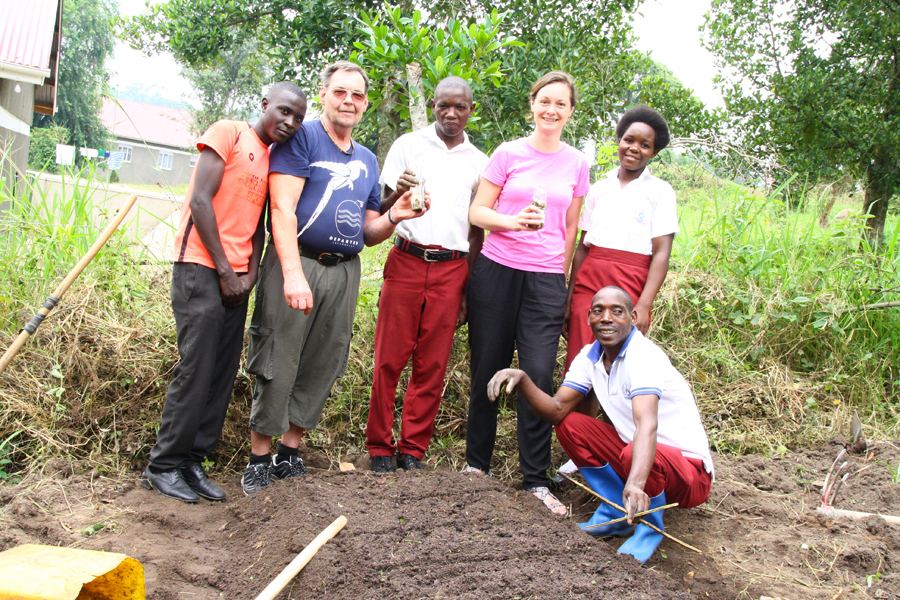
13. Laptopprojekt
Es wurden sieben neue von Labdoo gespendete Laptops aus Deutschland mit zum Projekt genommen. Vor Ort wurden die bereits gespendeten 45 Laptops geprüft und nicht mehr funktionsfähige aussortiert. Insgesamt waren alle 45 Laptops vorhanden und nur 7 davon nicht mehr funktionsfähig. Diese sieben Laptops wurden wieder mit nach Deutschland genommen und werden an Labdoo zurückgeschickt. Die vorhandenen Laptops sind den Umständen entsprechend gut gepflegt und werden dankbar genutzt, allerdings wurde häufig Microsoft Windows als Betriebssystem installiert obwohl dies ausdrücklich nicht erlaubt ist, da die Firma Labdoo nur Linux installiert. Der verantwortliche Lehrer und Annette wurden darüber informiert.
Das Laptopzimmer wird sehr genutzt, ist allerdings mittlerweile zu klein und ein zweites Laptopzimmer wäre wünschenswert. (von Philipp Oppelt)
14. Kontrolle Mittelverwendung
Es wurden die in 2019 an HONU übergebenen Geldzuwendungen geprüft.
Anwesend waren: die Buchhalterin Justin und Heidi Schettler
Die Prüfung fand stichprobeartig statt.
Die Bücher wurden alle nachvollziehbar geführt und zu allen Fragen wurde eine qualifizierte Antwort gegeben bzw. alle Fragen konnten geklärt werden.
Die Prüfung hat keine Beanstandungen ergeben.



